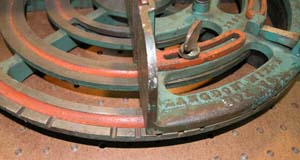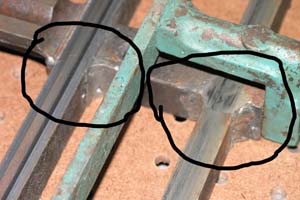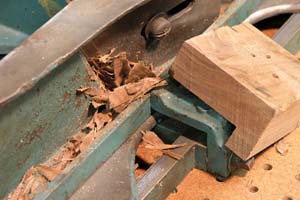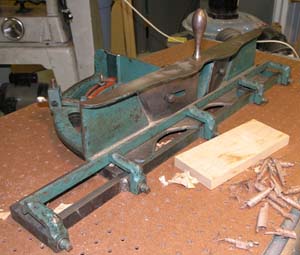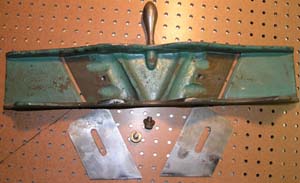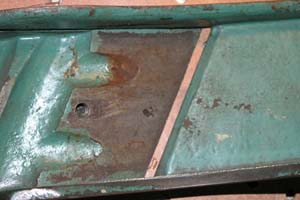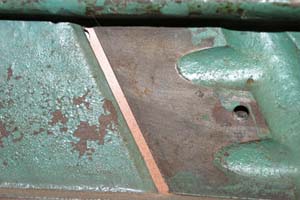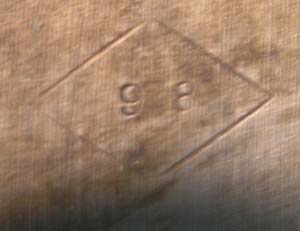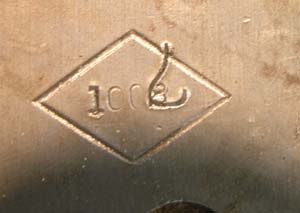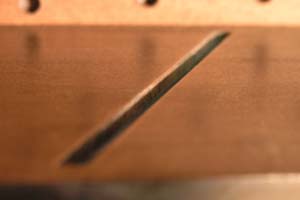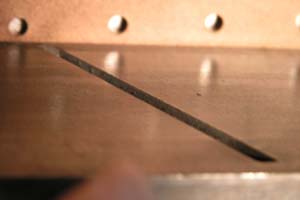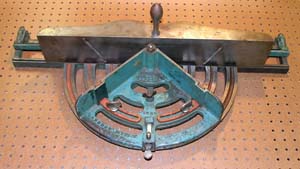 The
Rogers Patented Miter Planer
The
Rogers Patented Miter Planer
Cast iron, the middle of three sizes produced.
Retains much of it's original paint. Some places appear to have been touched up, but the paint in the main appears to be original.
Without moving the quadrant, both left and right miters can be planed, making quick work of framing tasks. Just cut the angles close with a handsaw, then trim them to exact fit on the Rogers Patented Miter Planer.
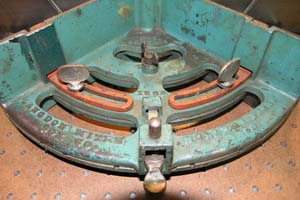 The
quadrant has edges that are 9 1/2 inches long. It is secured to the base
with a bolt at the pivot point and has a wing nut that secures the quadrant
into it's position for use. Originally the securing fastener would have
been a knurled knob, but this seems to have gone missing a long time ago.
The knurled knob is the only thing that appears to be missing from this
tool.
The
quadrant has edges that are 9 1/2 inches long. It is secured to the base
with a bolt at the pivot point and has a wing nut that secures the quadrant
into it's position for use. Originally the securing fastener would have
been a knurled knob, but this seems to have gone missing a long time ago.
The knurled knob is the only thing that appears to be missing from this
tool.
The quadrant casting has "Pat. Sept. 10, 1882"
"Langdon Mitre Box Co." "Millers Falls Mass."
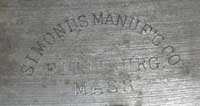 The
irons are marked "Simonds Manuf'g Co. Fitchburg Mass." One has
a diamond stamped under the Simonds line, the other has a stylized arrow
motif under the Simonds line.
The
irons are marked "Simonds Manuf'g Co. Fitchburg Mass." One has
a diamond stamped under the Simonds line, the other has a stylized arrow
motif under the Simonds line.The quadrant pivots and locks into indents in the base seen in this photo. The indents are located to produce angles of 90, 75, 67 1/2, 54, 49, and 45 degrees. The quadrant can also be locked into place anywhere in between the settings as well, making this tool an very versatile planing fixture.
 This
is the underside of the casting. In Roger K Smith's Patented Transitional
& Metallic Planes in America 1827 - 1927 an advertisement dated
1888 prices this plane at $25. A great deal of work went into the making
of this tool from casting and machining to painting and assembly.
This
is the underside of the casting. In Roger K Smith's Patented Transitional
& Metallic Planes in America 1827 - 1927 an advertisement dated
1888 prices this plane at $25. A great deal of work went into the making
of this tool from casting and machining to painting and assembly.
At one time in it's history the right side of the plane's tack was broken and repaired. This is a photo of the underside of the repair.
This is the top side showing the repair. The tool works fine and the repair is hardly noticeable. There is a slight drag on the plane as it moves from left to the far right side of the base, but this doesn't affect it's use at all.
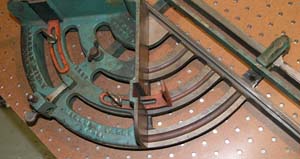 The
quadrant has two extendable guides that were designed to make easy work
of truing up the ends of curved pieces of work. This feature made the
Rogers Miter Planer a desirable tool for the patternmaker.
The
quadrant has two extendable guides that were designed to make easy work
of truing up the ends of curved pieces of work. This feature made the
Rogers Miter Planer a desirable tool for the patternmaker.
Another use facilitated by this design would be the fitting of parts in curved frames. The guides help to hold the work steady while the proper angle is planed.
I haven't sharpened the massive blades, but the tool still shaves end grain on walnut fairly cleanly. After a good honing the tool would be a joy to use.
This angle shows the way the plane fits into the track. The five supports can be shimmed to allow for wear on the track keeping the plane true to the work. There doesn't appear to be much wear to the track on this tool.
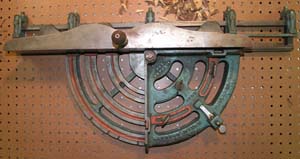 The
base casting is stamped with the number 7 twice near the corner of the
quadrant. The plane is also marked with the number seven stamped once
on each end of the base where it runs under the track in back.
The
base casting is stamped with the number 7 twice near the corner of the
quadrant. The plane is also marked with the number seven stamped once
on each end of the base where it runs under the track in back.
The base casting without the plane weighs in at 38 pounds. The tool will be shipped in two containers. One with the plane and another wooden box with the base casting.
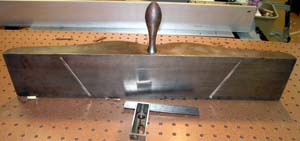 The
plane is 22 7/8th inches long 4 1/2 inches tall. The irons are 3 1/2 inches
high, which is what designates this plane as the middle size. It was also
made in a 2 inch and a 4 inch model. The blade, at it's longest point
in the skew is 6 inches long. The plane alone weighs 16 1/4 pounds. That's
a six inch square in front of the plane. (not included in the auction.)
The
plane is 22 7/8th inches long 4 1/2 inches tall. The irons are 3 1/2 inches
high, which is what designates this plane as the middle size. It was also
made in a 2 inch and a 4 inch model. The blade, at it's longest point
in the skew is 6 inches long. The plane alone weighs 16 1/4 pounds. That's
a six inch square in front of the plane. (not included in the auction.)
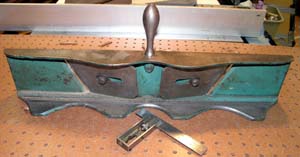 This
is the inside of the bed of the plane. The paint appears to be original.
There are some nicks and dings in the casting from use and storage, but
no rust or pitting. The letters O and H are stamped on the top of the plane
casting. The irons are secured with large slotted machine screw.
This
is the inside of the bed of the plane. The paint appears to be original.
There are some nicks and dings in the casting from use and storage, but
no rust or pitting. The letters O and H are stamped on the top of the plane
casting. The irons are secured with large slotted machine screw.
All content ©WJG2002-20010. All rights reserved.
No duplication or any other use without written consent.
For
permission email
me.
